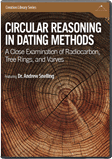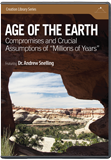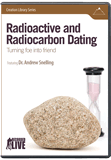Layers of Assumption
Are Tree Rings and Other “Annual” Dating Methods Reliable?
Secular scientists claim it’s easy to disprove the Bible’s 6,000-year history: just count the tree rings. But this dating method is not as reliable as you might think.
“Then God said, ‘Let there be lights in the firmament of the heavens to divide the day from the night; and let them be for signs and seasons, and for days and years.’” —Genesis 1:14
When you hear the name Methuselah, what do you think of?
Many of us think of Noah’s grandfather, who was 969 years old and the oldest man in the Bible.
But others, especially those who believe the earth is millions of years old, might first think of a well-known bristlecone pine in California’s White Mountains. It’s named Methuselah and claimed to be 4,849 years old. These days Methuselah is the old-earth poster child of Bill Nye “the Science Guy” and other secular science debaters who say we have proof that the earth is older than the Bible says.
Tree rings, ice cores, and other natural records of seasonal changes, they say, prove the earth is old and the Bible’s account of history can’t be true.
Yes, it’s true that the earth has cycles of constantly changing climate conditions, which we can observe in the way they impact animals, plants, and the environment. This is God’s wise plan for the nourishment and health of all life on earth, including us humans, who are made in His image.
While most of us rely on calendars to track seasons and years, God gave us other markers of the passage of time. For instance, every year trees really do grow a fresh layer of cells on their outer trunks—tree rings. If we count up the rings, we can calculate how old the tree is, right?
Each season, rains wash silt onto the bottoms of lakes. The content of the layers looks different in the spring and fall. So we can just count up the layers and know how long the lake has been there, right?
Polar ice sheets add new layers each winter, too. The snow never completely melts in the summer and is covered by a new blanket of snow the following winter. Just count up the layers, and you know how long snow has been falling near the poles, right? Secular scientists believe these layers clearly mark the passage of time and date the earth—whether rings in trees, sediment layers on lake floors (called varves), or layering in the ice sheets.
These dating methods seem well founded and logical because we can observe these seasonal processes happening today. Based on these dating methods, old-earth proponents have constructed chronologies from tree rings they claim go back at least 12,500 years, lake-floor layers representing 50,000 years, and ice layers going back 800,000 years.
The Bible, in contrast, indicates that earth is only about 6,000 years old. Should the dating of annual layers shake our faith in the reliability of God’s Word? Absolutely not, because God, who never lies, has given us His eyewitness account of the creation of the universe and all it contains. We have an infallible way to date history through the recorded human lineage of God’s Son, Jesus Christ, our Creator and Redeemer.
Although we can use annual dating methods to measure the passage of time in observed time, that doesn’t mean these methods are accurate for historical periods we didn’t observe. When secular scientists use these dating methods, they generally assume that the seasonal processes and conditions we observe today have always been the same. But that isn’t necessarily so. They also ignore the global cataclysmic impact of the biblical Flood—just as the Apostle Peter predicted modern-day scoffers would (2 Peter 3:3–6).
Let’s take a closer look at these specific dating methods and see what lessons we can learn.
Tree-Ring Dating
Tree-ring dating is not as simple as it might seem. It depends on subjective visual cross-dating, augmented by radiocarbon dating.
Dating tree rings is not as simple as it might seem. Several factors determine the growth rate of trees and the width of their growth rings—the soils, altitude, water table, climate, seasons, and weather. Droughts, fires, and periods of abnormally high rainfall will impact the growth pattern of tree rings, so a tree will not always have one growth ring per year.
Dendrochronology is the technical term for the science of counting the growth rings of trees to estimate the passage of years. Scientists don’t just look at living trees (like Methuselah), either. They search for buried trees and the beams of timbers in ancient buildings. If they know when the tree was cut down for a building (say, 1500 BC) and count the number of rings in the tree (say, 500), they logically conclude that the tree started growing 500 years before it was cut down (thus dating the first growth of the now-dead tree to 2000 BC).
This method allows scientists to measure the passage of time a lot farther back than the lifespans of living trees. Or so the theory goes.
In reality, it’s much more complicated than that. Scientists must visually compare the appearance of growth rings, noting where some rings appear thicker or thinner. They then match the patterns in dead trees to other trees. (They limit their study to one tree species. This ensures that the estimates aren’t misled by variations in growth patterns of different species.) In this way, scientists establish a hypothetical series of rings, some thin and some thick, going back thousands of years for each species.
This is called a master chronology, or timeline, for the species. Whenever scientists find a new log or beam, they can theoretically match the ring patterns in that beam to their hypothetical series.
Yet this involves massive layers of questionable interpretation. Matching growth rings between different wood samples is called “cross-dating” or “cross-matching.” Though it seems this matching would be easy, counting growth rings is tedious, and visually cross-matching similar ring patterns and specific growth rings from sample to sample is highly subjective. There can be major variations from tree to tree in a forest and, accordingly, in the wooden beams used to build houses.

photo by Greg Boratyn
Bristlecone pines are hardy trees living high in the western mountains of the US. Some are claimed to be among the oldest living things on earth.
So scientists don’t rely on visual comparisons. They use radiocarbon (14C) dating of growth rings to obtain their approximate age. Then they match this information to the associated pattern of rings in the master tree-ring chronology. However, ironically, radiocarbon dating is calibrated and corrected using tree-ring chronologies. So conclusions about tree-ring ages depend on radiocarbon dating, which depends on tree rings, which depends on radiocarbon dating. Neither tree-ring counting nor radiocarbon dating is conclusive alone.
The most famous tree-ring chronology is derived from bristlecone pines, which are found in isolated groves at high mountain altitudes in the US Southwest. The trees grow very slowly in dry, limy soils under harsh, cold, and windy weather conditions. Yet they are highly resilient and long-lived. Their wood is extremely durable, which makes them valuable for dating back a long time. But their growth rings are very thin, making them hard to count. (And we don’t have any historical buildings in the US Southwest for cross-referencing.)
We’ve mentioned the poster child of tree-ring dating: the well-known bristlecone pine in California’s White Mountains. It is named Methuselah and is touted as being 4,849 years old. Scientists claim that other trees in secret locations nearby are even older.
The bristlecone pine tree-ring chronology was first constructed in 1970. Initially researchers dated it back 7,000 years, but they have extended its age back over 9,000 years. One problem: the living trees account for only 1,200 years of the chronology, and the whole chronology depends on the accuracy of only two specimens—one living and one dead—where the growth rings appear to overlap (see diagram).1 If any mistakes appear in the interpretation of these two specimens, the whole chronology crumbles.
In 1970 the scientists who made the master tree-ring chronology relied on a data set of 315 radiocarbon (14C) measurements from a collection of bristlecone pine wood samples. But it is well known that the 14C content of the atmosphere has varied considerably in the past because of climate changes and fluctuations in the amount of cosmic-ray radiation reaching the earth. For example, periods of low cosmic-ray activity would dilute the radioactive carbon (14C) in the tree rings, making the ages appear much greater than they really are.
As we saw earlier, tree-ring dating depends on subjective visual cross-dating, augmented by radiocarbon dating. So tree-ring dating relies on radiocarbon dating, while radiocarbon dating has been corrected using tree-ring dating! In the world of logic, that is called circular reasoning—a person uses one assumption to prove another assumption, but neither has an unimpeachable, independent basis of measurement.
Weak Links in Bristlecone Chronology
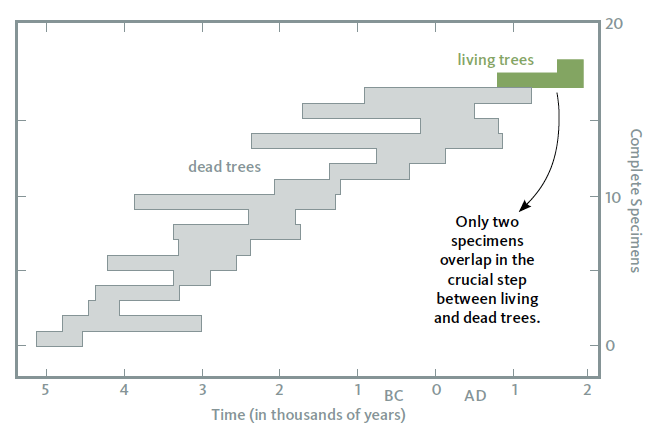
Only two living trees appear in the tree-ring chronology for bristlecone pines, and they go back only 1,200 years. Any mistake in lining up those trees with the next ones undermines the whole chronology. Mistakes in lining up other trees in the series would also ruin the whole chronology.
Varve Dating
At the bottom of still bodies of water, such as lakes, are layers of deposits called varves. Each varve has two different kinds of layers (technically, laminae), one assumed to have been deposited over the summer and the other deposited in the winter. What is called the “summer” layer has relatively large grains of light-colored sediment—usually sand or silt. These grains washed into the lake when spring rains rushed across the landscape and picked up coarse, heavy sand and dirt. A thinner “winter” layer consists of very fine-grained (clay-like) sediment, often dark particles from plants and other living things, which floated in water and slowly settled onto the bottom of the lake. The thick, coarse “summer” layer and the fine “winter” layer make one varve.
Varve dating has a problem similar to tree-ring dating. It is based on the assumption that the pattern and rate of lake deposits have continued in the same way throughout the past.
Those who measure varves must also assume that all the layers are indeed varves. Yet another phenomenon can produce similar results. Rhythmites are thin laminae from natural catastrophes that produce a rhythmic ebb and flow of rushing water. Rhythmites are nearly indistinguishable from varves. A single event, such as a dam break or slow-moving hurricane, can deposit a series of many sedimentary layers. Rhythmites don’t necessarily carry any time or seasonal connotations. Huge amounts of water can rapidly deposit many alternating laminae, each with distinctive features, in a single week (or in hours, in the case of a dam break).
Let’s look at a few observed events that deposited multiple thin layers, and then compare those deposits with the rhythmites and claimed varves in the geologic record.
One example is the eruption of Washington’s Mount St. Helens on May 18, 1980. Landslides, mudflows, steam water, falling volcanic ash, and volcanic ash flowing on the ground deposited a sequence of sediment layers up to 600 feet thick near the volcano. The most surprising accumulations resulted from several slurries of ash that moved from the volcano at up to 90 miles per hour. These deposits were filled with different layers, including fine volcanic ash beds ranging in thickness from a fraction of an inch to three feet. Each bed was laid in just a few seconds to several minutes.
One of these was a 25-foot-thick layered deposit that accumulated in only three hours on June 12, 1980. It consisted of many thin laminae in an alternating pattern of fine-grained and coarse-grained layers, similar to varves. But these were not deposited by alternating conditions; instead they were deposited all at once from the same fast-moving slurries.
Though volcanic ash slurries behave a little differently from waterborne silt and mud, geologists acknowledge that the processes of depositing the materials are essentially the same. This shows us that rhythmites that look like varves can be deposited all at once during catastrophic events. If conditions on earth were ever more severe than they are today (and they were, according to the Flood model of earth history), then we would expect to find many rhythmites in lakes.
So counting the alternating fine and coarse laminae, like in varves, does not indicate years of deposition.
Another example is Hurricane Donna, which flooded south Florida in 1960, depositing a 6-inch-thick mud layer with numerous thin laminae. The June 1965 flood in Bijou Creek, Colorado, deposited a sediment layer with more than 100 laminae in 12 hours.
Recent sedimentation in Walensee, Switzerland, reveals that while an average of two laminae have developed per year, in some years rapidly flowing water has deposited as many as five layers on the bottom of the lake.
Furthermore, scientists sometimes find vast, contradictory results among their own dating methods. Scientists have pursued a long-term, extensive study of places with “varves” in Sweden and North America—each with a few hundred laminae—to create comprehensive varve chronologies. But they have run into trouble. Based on counting varves, they first estimated a chronology of 28,000 years for North America. But the same data was reinterpreted as only about 10,000 years based on radiocarbon dating.
Think about what this means. Counting varves is supposed to be more reliable than radiocarbon dates, which are usually corrected by varve and tree-ring counts! So is varve dating reliable? Absolutely not. There is no guarantee that alternating laminae are indeed genuine measurements of yearly sediment build-up. Instead, they could easily be multiple rhythmites deposited during storms or other events. And varve counts even fail when they’re cross-checked with radiocarbon dating. Varve dating is not independent of radiocarbon dating, but depends on it. Furthermore, radiocarbon dating is calibrated, or refined, against tree-ring dating, which is calibrated by radiocarbon dating!
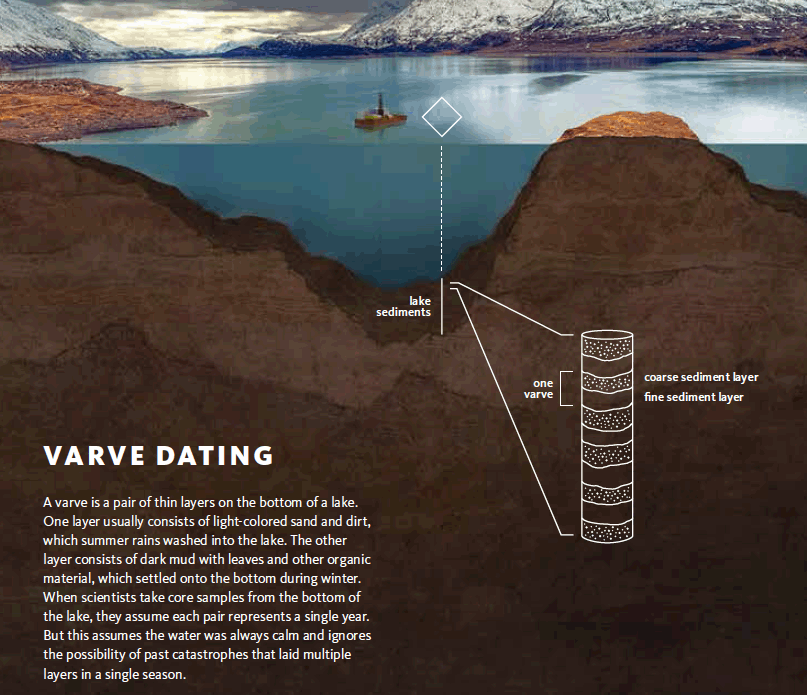
Ice Core Dating
Now let’s turn to another popular example of annual dating—ice cores. To determine how long it took for polar ice sheets to grow, scientists obtained long cores from Greenland and Antarctica. Examining these ice cores, they saw layering in the top sections. They assumed these layers represented annual accumulations of snow in the colder months, separated by lack of snowfall and some surface melting during warmer months.
However, farther down in the ice cores these layers became blurred, and they were obliterated for much of the lower part of the cores. This was obviously due to the weight of snow and ice pressing down on the deeper ice.
So they looked for another way to identify what they assumed was annual layering through these ice cores. They found that the relative balance of different kinds of oxygen atoms varies in the snow and ice with what they assumed were seasonal accumulations. As ocean water evaporates, more of the heavier oxygen atoms (18O) get left behind, and the resulting snowfall has a slightly higher proportion of lighter oxygen atoms (16O). They compared the ratios of oxygen atoms down the ice cores, assuming the fluctuations reflected yearly layers.
Also, volcanic eruptions left layers of dust that got trapped in the accumulating ice. So scientists shined light through the ice cores to detect slightly darker layers containing volcanic dust. They can also measure fluctuations of different chemicals. Putting all this together, the old-earth scientists created an ice core chronology, which they claimed dates back up to 800,000 years.
This is all based on the assumption that only one ice layer accumulates every year. What if multiple ice layers have accumulated every year?
However, this is all based on the assumption that only one ice layer accumulates every year. What if multiple ice layers have accumulated every year? Multiple evidences point to that very thing.
Consider the World War II fighter plane abandoned on a Greenland glacier in 1942. When history buffs tried to recover the plane 46 years later, they were astonished to find that more than 250 feet (75 m) of ice had already entombed it. That 250 feet held many more layers than the 50 it should have had if only one layer had accumulated every year.
And we don’t have to be scientists to know that snow usually leaves more than one layer a year. Snow layers are visible every time snow falls through the winter months. When you clear your driveway or sidewalk of snow, you can see snow layers in the banks of accumulated snow you just shoveled through.
Dr. Larry Vardiman, former atmospheric physicist for the Institute for Creation Research, and his graduate students tested alternative possibilities. They examined computer records of known storms to simulate their behavior if the surface of the ocean were hotter, as it was in the early decades after the Flood. (Remember those hot volcanic waters that were released from “the fountains of the great deep” at the start of the Flood? They would have raised the ocean water temperatures considerably.)
These researchers found that huge storms would have swept across polar regions, dumping many inches of snow every week. As the surface melted between these storms, 20 or more ice layers could easily have accumulated every year during the first century or two after the Flood. The same time period saw many dust-producing volcanic eruptions, as supervolcanoes rocked the earth and the planet settled into relative quiet after the cataclysmic upheavals of the Flood. So most of the ice core layers would probably have accumulated during the turbulent centuries of the post-Flood Ice Age.

Not So Impeccable After All
At first glance these seasonal and annual dating methods appear to be impeccable. We observe the annual growth rings in trees, and the accumulations of sediment and ice layers. After the Flood, God promised Noah that the seasons would be reliable (Genesis 8:22), but we cannot assume that natural cycles deposited only one layer each year. That kind of dating method yields vastly older ages than the biblical chronology of earth history would allow.
Our closer investigations have revealed fatal flaws in these methods. Tree-ring counts need to be cross-checked with radiocarbon dating, which itself is calibrated against tree-ring counts. Layers on lake floors (varves) may instead be many multiple sediment laminae deposited in single storm events. Also, varve counts have to be corrected using radiocarbon dating! And then most of the layers in ice cores were likely produced by the accumulating almost-weekly snowstorms in the early centuries after the Flood.
So what’s more reliable? The unprovable dating methods of humans—where tree-ring counts need to be cross-checked with radiocarbon dating, varve counts are corrected using radiocarbon dating, and ice cores are measured based on minor atomic fluctuations caused by individual storms?
Or the dating methods of an infallible God?
This all confirms that we need to anchor all of our thinking in the divine eyewitness testimony of earth history as recorded in God’s Word. Whenever the Bible’s historic reliability is challenged by human dating methods, we need to peel away the layers of assumptions and dig deeper into the observations, basing our assessments on what the Scriptures tell us about the earth’s early history.
Then we will always discover that God’s Word, rightly understood, never contains errors. And since we can absolutely trust its recorded history, we can trust ourselves and our futures to the care of our Creator and Redeemer, Jesus Christ, who has promised never to leave or forsake us (Hebrews 13:5). That is not an assumption, but a fact we can rest our lives upon.
Three Faulty Assumptions
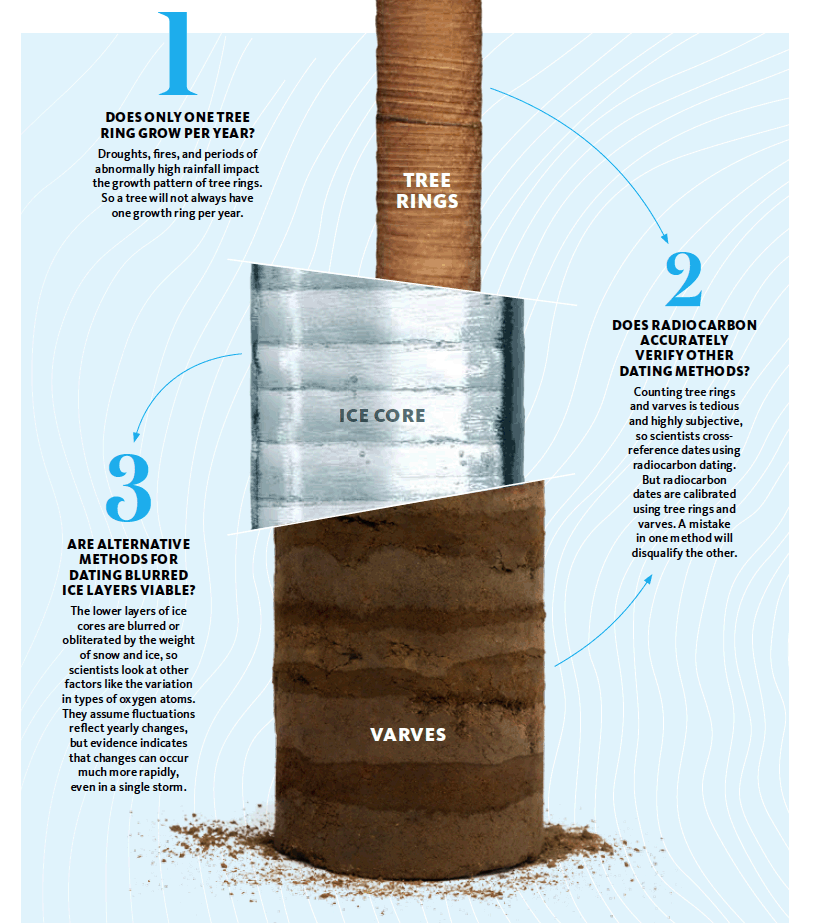
Dating methods are not as straightforward as they seem. It’s not as simple as counting layers; scientists must make several assumptions to fill in gaps.
Related Videos
Radiocarbon, Tree Ring, and Varve Dating Excerpt
Answers Magazine
January–February 2017
Secular scientists claim it’s easy to disprove the Bible’s 6,000-year history: just count the tree rings. But this dating method is not as reliable as you might think.
Browse Issue SubscribeFootnotes
- C.W. Ferguson, “Dendrochronology of Bristlecone Pine Pinus artistata. Establishment of a 7484- Year Chronology in the White Mountains of Eastern-Central California, USA,” in Radiocarbon Variations and Absolute Chronology, Proceedings of the 12th Nobel Symposium, ed. I.U. Olsson (New York: Wiley), pp. 571–593. Diagram cited in Radiogenic Isotope Geology, 2nd ed., Alan P. Dickin, p. 388. Cambridge, UK: Cambridge University Press (2005). Because the identity of the trees used to construct this bristlecone pine tree-ring chronology are not provided in the published literature, it is not at all clear whether any of Methuselah’s >4000 rings were actually used in it.
Recommended Resources

Answers in Genesis is an apologetics ministry, dedicated to helping Christians defend their faith and proclaim the good news of Jesus Christ.
- Customer Service 800.778.3390
- © 2024 Answers in Genesis





